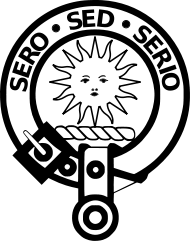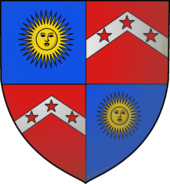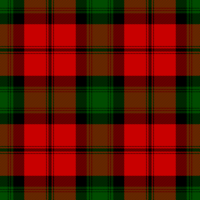- Clan Kerr
-
Clan Kerr Crest badge 
Crest: The sun in his spledour Or Motto: Dexter, Sero sed serio (Late but in earnest). Sinister, Forward in the name of God Slogan: Late but in Earnest Profile District Scottish Borders Plant badge Bog Myrtle Gaelic name Cearr (Surname), MacGhillechearr (Surname), Cearrach (Singular), Na Cearraich (Collective) and Clann 'icGhillechearr (Collective). Chief

The Most Hon. Michael Kerr The 13th Marquess of Lothian Seat Ferniehirst Castle Septs of Clan Kerr Kear, Carr(e),Carrach, Cessford, Kar(e), Karr, Ker, Mac Ghiolla Cheara, Kier, Keir, Linton,Herriott Clan branches Kerr of Ferniehurst (chiefs, Marquess of Lothian)
Ker of Cessford (Duke of Roxburghe)
Kerr of Linton
Ker of KerslandAllied clans Clan Leslie Rival clans Clan Scott Clan Kerr is a Scottish clan that played an important role in the history of the Border country of Scotland.
Contents
History
Origins
The origins of the name Kerr are disputed as being either:
- Caer (British for "fort")
- Ciar (Scottish Gaelic for "dusky")
- Ceàrr (Scottish Gaelic for "left-handed" – carrie handit in Lowland Scots)
- Mac Ghiolla Cheara (Irish language)
- Kjrr, Kjárr, or Kíarr,(Old Norse is a figure of Norse mythology that is believed to be the reflection of the Roman Emperors. In Old Norse sources, he appears as a king of the Valir (Celtic/Romance southerners)who were the people of Valland (the Celtic/Roman south")
Asked how to say his name, Admiral Mark Kerr told The Literary Digest "In Scotland the name rhymes with care. Since many of the family have come to England the pronunciation in this country rhymes with car, which we have entirely submitted to." (Charles Earle Funk, What's the Name, Please?, Funk & Wagnalls, 1936.)
The great Clan Kerr/Carr is well remembered in Scotland as one of the most loyal but warlike Clans of the turbulent Border territories. They arrived in Britain after William I's conquest of England in 1066. The Clan descends from two brothers, Ralph and John Ker, who settled in Jedburgh around 1330.[citation needed] The Clan soon grew and prospered, building themselves a position of influence through their sheer strength and tenacity. They controlled two castles on the border with England, and were quick to fend off any intrusion by the Southerners, but were not indisposed to a quick venture across the divide whenever they fancied some prime English beef for their tables. Rival Scottish border clans included Clan Heron and Clan Scott.
15th century
By the 15th century the Clan Kerr/Carr were important Crown vassals, and with loyalty came rich rewards. In 1451 Andrew Kerr was granted the barony of Old Roxburgh, and by 1457 had been created the Warden of the Marches. By the close of the 15th century, the Clan Kerr held the honours of possessing the Castle and Barony of Cessford, and the Barony of Oxnam, a considerable achievement for any Border Clan.
The Kerrs/Carrs were often at feud with other Scottish border clans including Clan Scott and Clan Heron. They would meet for battle at a place called Bellendean. The feuding would cost the lives of both the Clan Kerr and Clan Scott Chief.
16th century, clan conflicts and Anglo-Scottish Wars
In 1502 the barony of Oxnam became Sir Andrew Kerr of Ferniehurst's by royal charter and he became warden of the middle marches. A few years before the Battle of Flodden Field three Englishmen killed Sir Robert Kerr, a former warden of the middle march, while he was attending a march across the Border, and his son tracked down one of the murderers and gave him what was known as "Jeddart justice".
The Clan's faithfulness to the Crown of Scotland continued throughout the centuries. They fought under their chief, Sir Andrew Kerr, at the Battle of Flodden Field in 1513, standing beside King James IV of Scotland in his conflict with the English armies. Once when defending one of the Border Country Castles from an English attack, it is said that the English besiegers believed the Kerrs defending were being aided by the 'devil himself', as they fought so ferociously.[citation needed]
After the Battle of Flodden Field, some of the Leddesdale clans put themselves under the Kerr of Ferniehurst's protection, but in 1523 his castle was taken by the English after a protracted defence. The Chief Kerr of Cessford, who had worked as warden for peace and co-operation with England, was killed by a follower of Clan Scott of Buccleuch in the attempt to rescue King James V of Scotland from the Clan Douglas. Thirteen years after the Battle of Flodden Field, Sir Andrew died in defence of the infant King James V of Scotland when the royal procession was attacked on the way to Edinburgh Castle.
The feud between the Clan Scott and Clan Kerr/Carr continued and in 1552 Walter Scott of Branxholme and Buccleuch, Chief of Clan Scott of Buccleuch was killed by the Kerrs of Cessford in Edinburgh.[1] Fighting between the two clans continued until a peace agreement was signed in 1602.
Honours continued to be heaped upon the Clan down through the years, with the titles bestowed on the Kerrs including the Barony of Newbattle, the Earldom of Lothian, the Lordship of Jedburgh, the Earldom of Ancram, and the Dukedom of Roxburghe.
Mark Kerr, had his lands of Newbattle and Prestongrange erected into the barony of Newbattle by a charter of 1591
17th century
In 1606 Mark Kerr was created Earl of Lothian. This title failed when his son died in 1624 without male issue also his daughter died in 1626 when giving birth to twins. Sir Andrew Kerr of the Ferniehurst line was created Lord Jedburgh in 1621.
The third peerage to come to the family was the earldom of Ancram, which was bestowed upon Sir Robert Kerr who was descended from a younger son of Sir Andrew Kerr of Ferniehurst. Sir Robert of Cessford, who now spelt his surname with a single ‘r’, was created Earl of Roxburghe in 1616. To add to the plethora of honours showered on the family, Sir William Kerr, son of the Earl of Ancram, was granted a new earldom of Lothian in 1631. His son, Robert, who was advanced to the rank of Marquess, also succeeded to the earldom of Ancram on the death of his uncle.
During the Civil War, Clan Kerr/Carr supported the Parliamentary Covenantor army of General David Leslie. In 1649 a rebellion took place in the north by the Covenantors of the Clan MacKenzie who were opposed to Leslie's parliamentary forces. As a result Leslie's forces under Colonel Kerr took the MacKenzie's Redcastle, demolished it and hanged the garrison.[2]
18th century and Jacobite uprisings
The Earls of Lothian were advanced to the rank of Marquess at the beginning of the 18th century.
At the beginning of the 17th century King James of Scotland was also made King of England in the Union of the Crowns in 1603, after Queen Elizabeth I of England died without heir. A century later in 1707 the Treaty of Union was declared officially uniting England and Scotland. This was supported by the Kerrs.
Lord Mark Kerr son of the Chief Marquess of Lothian, was a distinguished professional soldier and is reputed to have had a high sense of personal honour and a quick temper. He fought several duels throughout his military career but rose ultimately to the rank of general, and was appointed governor of Edinburgh Castle in 1745.
During the Jacobite Uprisings Clan Kerr supported the British government. At the Battle of Culloden in 1746 Lord Mark Kerr's younger brother, Lord Robert Kerr, who was captain of the grenadiers in Barrel's regiment, received the first charging Cameron on the point of his Spontoon, but then a second cut him through the head to chin. He has the dubious distinction of being the only person of high rank killed on the Government side.
The eldest of the brothers, Lord Mark Kerr, later the fourth Marquess of Lothian, commanded three squadrons of Government cavalry at the Battle of Culloden and survived to serve under the Duke of Cumberland in France in 1758.
Left-handedness
The Kerrs have typically been associated with left-handedness; some of their buildings, such as Ferniehirst Castle, have been explicitly designed with this in mind.[3] There is an anecdotal link between the Kerrs and left-handedness, although it is unclear whether or not present-day individuals with the surname of Kerr have a higher incidence of left-handedness than the general population[citation needed]. An article appearing in the BMJ circa 1972 confirmed that about 30% of those with the surname Kerr were left-handed as opposed to a background 10% of the population. However, a 1993 study found no statistically significant increase in left-handedness among people with the family name Kerr or Carr.[4]
Castles
- Ferniehirst Castle (sometimes spelt Ferniehurst) was built around 1470 to hold the gate for Scotland and to serve as a base for military raids and cattle-lifting forays. It commands the road to Otterburn and Newcastle. For 50 years in the 20th century, it housed a Youth Hostel, but it has been converted back into a residence.
- Newbattle Abbey or Newbattle Castle near Edinburgh became a secular lordship for the last commendator, Mark Kerr, 1st Earl of Lothian (Ker) in 1587.
- Floors Castle is another great monument to the Kerr's success.
- Roxburgh Castle is just across the Tweed from Floors Castle.
- Castle Holydean was destroyed in 1276 and very little of it now remains.
- Cessford Castle, a massive L-plan castle.
- Nisbet House, a 17th century tower house.
Chief
- Clan chief: Michael Andrew Foster Jude Kerr, 13th Marquess of Lothian
- Arms: Quarterly, 1st & 4th, Azure, the sun in his splendour Or (for the peerage of Lothian); 2nd & 3rd, Gules, on a chevron Argent, three mullets of the field (Kerr)
Tartans
Clan Kerr has Three recognised tartans:
- Kerr (Modern)
- Kerr (Hunting)
- Kerr (Muted)
Notes and references
- ^ MacDonald Fraser 1972, p. 180
- ^ "www.electricscotland.com" (PDF). http://www.electricscotland.com/mackenzie/images/CHAPT.09.pdf.
- ^ "Overview of Kerr". http://www.scottish-places.info/families/familyfirst99.html.
- ^ Shaw, D.; McManus, I. C. (1993). "The handedness of Kerrs and Carrs". British Journal of Psychology 84: 545–51.
Bibliography
- MacDonald Fraser, George (1972). The Steel Bonnets. Alfred A. Knopt. ISBN 0394470494.
External links
- www.kerrfamilyassociation.com – Kerr Family Association of North America
- Kerr Heraldry
Scottish clans Clans with chiefs Agnew · Anstruther · Arbuthnott · Arthur · Bannerman · Barclay · Borthwick · Boyd · Boyle · Brodie · Broun · Bruce · Buchan · Burnett · Cameron · Campbell · Carmichael · Carnegie · Cathcart · Charteris · Chattan · Chisholm · Cochrane · Colquhoun · Colville · Cranstoun · Crichton · Cumming · Darroch · Davidson · Dewar · Drummond · Dunbar · Dundas · Durie · Elliot · Elphinstone · Erskine · Farquharson · Fergusson · Forbes · Forsyth · Fraser · Fraser of Lovat · Gayre · Gordon · Graham · Grant · Gregor · Grierson · Guthrie · Haig · Haldane · Hamilton · Hannay · Hay · Henderson · Home · Hope · Hunter · Irvine · Jardine · Johnstone · Keith · Kennedy · Kerr · Kincaid · Lamont · Leask · Lennox · Leslie · Lindsay · Lockhart · Lumsden · Lyon · MacAlister · MacBain · MacDonald · Macdonald of Clanranald · MacDonald of Keppoch · Macdonald of Sleat · MacDonell of Glengarry · MacDougall · Macdowall · MacIntyre · Mackay · Mackenzie · Mackinnon · Mackintosh · Maclachlan · Maclaine of Lochbuie · MacLaren · MacLea (Livingstone) · Maclean · MacLennan · MacLeod · MacLeod of Lewis · MacMillan · Macnab · Macnaghten · MacNeacail · MacNeil · Macpherson · MacTavish · MacThomas · Maitland · Makgill · Malcolm (MacCallum) · Mar · Marjoribanks · Matheson · Menzies · Moffat · Moncreiffe · Montgomery · Morrison · Munro · Murray · Napier · Nesbitt · Nicolson · Ogilvy · Oliphant · Primrose · Ramsay · Rattray · Riddell · Robertson · Rollo · Rose · Ross · Ruthven · Sandilands · Scott · Scrymgeour · Sempill · Shaw · Sinclair · Skene · Spens · Stirling · Strange · Stuart of Bute · Sutherland · Swinton · Trotter · Urquhart · Wallace · Wedderburn · Wemyss · Wood ·
Armigerous clans Abercromby · Abernethy · Adair · Adam · Aikenhead · Ainslie · Aiton · Allardice · Anderson · Armstrong · Arnott · Auchinleck · Baillie · Baird · Balfour · Bannatyne · Baxter · Bell · Belshes · Bethune · Beveridge · Binning · Bissett · Blackadder · Blackstock · Blair · Blane · Blyth · Boswell · Brisbane · Buchanan · Butter · Byres · Cairns · Calder · Caldwell · Callender · Campbell of Breadalbane · Campbell of Cawdor · Carruthers · Cheyne · Chalmers · Clelland · Clephane · Cockburn · Congilton · Craig · Crawford · Crosbie · Cunningham · Dalmahoy · Dalrymple · Dalzell · Dennistoun · Don · Douglas · Duncan · Dunlop · Edmonstone · Fairlie · Falconer · Fenton · Fleming · Fletcher · Forrester · Fotheringham · Fullarton · Galbraith · Galloway · Gardyne · Gartshore · Ged · Gibsone · Gladstains · Glas · Glen · Glendinning · Gray · Gunn · Haliburton · Halkerston · Halket · Hepburn · Heron · Herries · Hogg · Hopkirk · Horsburgh · Houston · Hutton · Inglis · Innes · Kelly · Kinloch · Kinnaird · Kinnear · Kinninmont · Kirkcaldy · Kirkpatrick · Laing · Lammie · Langlands · Learmonth · Little · Logan · Logie · Lundin · Lyle · MacAulay · Macbrayne · MacDuff · MacEwen · MacFarlane · Macfie · Macgillivray · MacInnes · MacIver · Mackie · MacLellan · Macquarrie · Macqueen · Macrae · Masterton · Maule · Maxton · Maxwell · McCorquodale · McCulloch · McKerrell · Meldrum · Melville · Mercer · Middleton · Moncur · Monteith · Monypenny · Mouat · Moubray · Mow · Muir · Murray of Atholl · Nairn · Nevoy · Newlands · Newton · Norvel · Ochterlony · Orrock · Paisley · Paterson · Pennycook · Pentland · Peter · Pitblado · Pitcairn · Pollock · Polwarth · Porterfield · Preston · Pringle · Purves · Rait · Ralston · Renton · Roberton · Rossie · Russell · Rutherford · Schaw · Seton · Skirving · Somerville · Spalding · Spottiswood · Stewart · Stewart of Appin · Strachan · Straiton · Strange · Sydserf · Symmers · Tailyour · Tait · Tennant · Troup · Turnbull · Tweedie · Udny · Vans · Walkinshaw · Wardlaw · Watson · Wauchope · Weir · Whitefoord · Whitelaw · Wishart · Young
Culture and society Scotland · Clan chief · Septs · Clan badge · Clan crest · Clan battles · Tartan · Bagpipes · Clearances · Kilt · Manrent · The Highlands · Battle of Culloden · Highland games · Border Reivers · Scottish heraldry · Scottish surnames
Categories:- Scottish clans
- Scottish Borders
- Scoto-Norman clans
Wikimedia Foundation. 2010.

